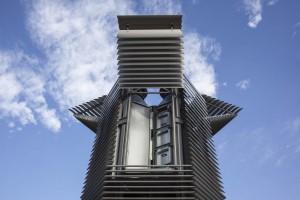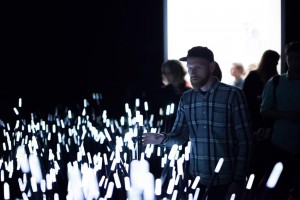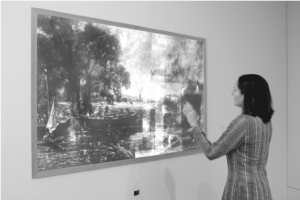We humans have created technologies and machines to enhance our lives, we invented cars to liberate ourselves, built all kinds of factories to raise efficiency, but now these innovations are striking back, making the environment extremely polluted in high-density cities; some visible, while others may be invisible, but still left the real impact on our daily life and health. Think about donating 50 euro to get a Smog Free Ring[x], which contains smog filtered from 1000 m3 of air, in order to support the Smog Free Tower and Smog Free Project by Studio Roosegaarde.
Will this make a real contribution to solve the problem of pollution? By purchasing a Smog Free Cube, Ring, or Cufflink, are you purchasing a souvenir, a design or are you building your association with the Smog Free Project, the anti pollution movement?


Daan Roosegaard’s Smog Free Ring • Smog filter in Bejing
Our technical interaction with artworks has only developed within the last decade at the level of using touch screen to improve the understanding of drawings, but now in the art and design world, both these two elements have been introduced to the real application domain.


Daan Roosegaard’s public interactive landscape Dune (2006-2012) • John Constable: The Great Landscapes” 2006
To gain a better understanding of this change, we can look at Daan Roosegaard’s public interactive landscape Dune[x] (2006-2012) which interacts with human behavior, and the Tate Britain exhibition “John Constable: The Great Landscapes[x]” in 2006. The Great Landscape used X-Ray examination and Drawing screen to help the visitors to obtain an understanding of Constable’s working practice and techniques through body movements in front of the X-Ray projection and figure movements on the touch screen (Engaging Constable: Revealing Art with New Technology), while Dune served itself, stood for a hybrid of nature and technology, artwork and the way to present the artwork. It is composed of large amounts of fibers that brighten and made sounds according to the sound and motions of visitors. Both enhanced social interactions with the help of sense-based technologies and being recorded with cameras and microphones in order to study and analyze people’s interactions, Dune and The Great Landscape had quite different starting points.
The visual impact of the eyes decrease as the other senses are heightened due to the introduction of tactility and sound, thus the aesthetic value is no longer of primary importance and the design opens up a broader spectrum of uses and practicality. This also explains Daan Roosegaard’s later works, how he uses modern technology to deal with multiple subjects; such as the relationship between intimacy and body (high-tech fashion project Intimacy[x], 2010), the historical heritage and sustainable idea (Van Gogh Path[x] [x], 2014), the power and poetry of living with water in Netherlands (Waterlicht[x], 2015 and Icoon Afsuiltdijk[x]).
The modern presentations of art and design in museums and galleries provide personal and collaborative experiences as The Great Landscape did, but Roosegaarde’s tactile high-tech environments enable the viewer and space to become one, not only because it can encourage more people to interact with each other and the environment simultaneously, but also because the technology leads the viewers to become both users and performers, thus the art raises people’s awareness of public issues.
Concerning its unique background associated with environment protection and sustainable development, the Smog Free Ring distances itself completely from traditional souvenirs in a museum and the association created by purchasing it, just as putting yourself in the Dune and reacting with it stands apart from the traditional way to appreciate an artwork. But is this different to other design works which also aim to serve a better life?
As science and technology are an essential part of his work, I want to introduce the Three Cycle Review of Design Science Research from Alan R.Hevner’s “A Three Cycle View of Design Science Research”.
A Three Cycle View of Design Science Research [download as pdf]
Design Science Research is motivated by the desire to improve the environment by introducing new and innovative artifacts and processes. The Three Cycle Review of Design Science Research consists of Relevance Cycle, Design Cycle and Rigor Cycle. Good Design Science Research often starts by identifying problems in an actual application environment or recognizing the potential to improve a practice before a new problem occurs. When applied to the Smog Free Tower, people’s neglect towards air pollution interested Daan to think about building the largest purifier in order to solve the problem. In the Relevance Cycle, the air-polluted environment is not only where the problem is found, but also a testing field in order to see if the design results meet the criteria. Then, they moved to Rigor Cycle and the knowledge base and found the existing air purification technology which is used in the hospital. Following the search for technology, they moved to the internal Design Cycle, and built the Smog Free Tower based on the original issue found in the environment and the technology found in the knowledge base. While the artifact is being built, field testings are input from the relevance Cycle and the design and evaluation methods to Relevance Cycle and Rigor Cycle. After several rounds of improvement, The Smog Free Tower and The Smog Free Ring, which contained both technology and beauty were born.
To give a brief conclusion, pragmatic science, interaction between human, responsibility for the living environment and beauty are core components in Daan Roosegaard’s works and in the future world of art and design. But not only the world of art and design, or let’s say, since art and design has gradually found their new position in 21th Century, they will no long serve aesthetics as the core matter. Techno Beauty, as how Daan Roosegaard described his own works, may becomes a direction in design to beautify and save the world.
